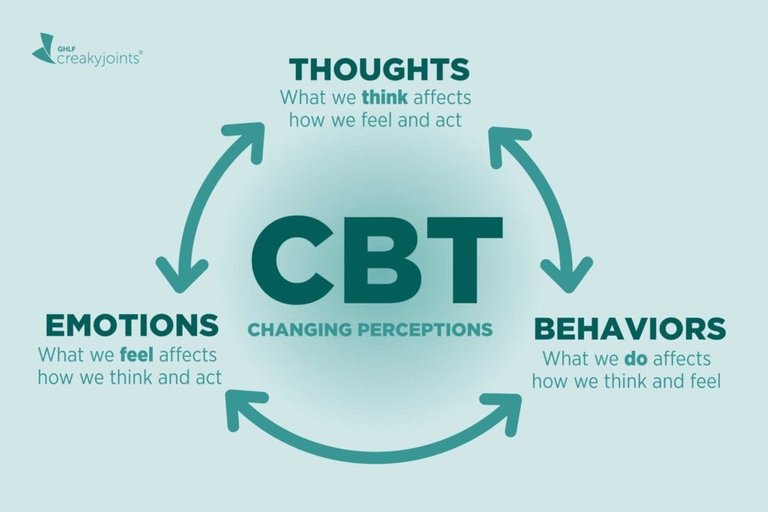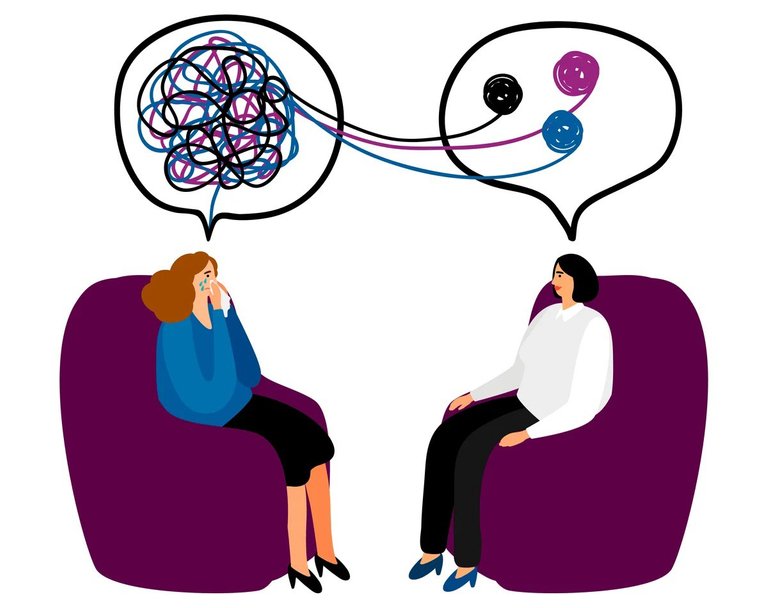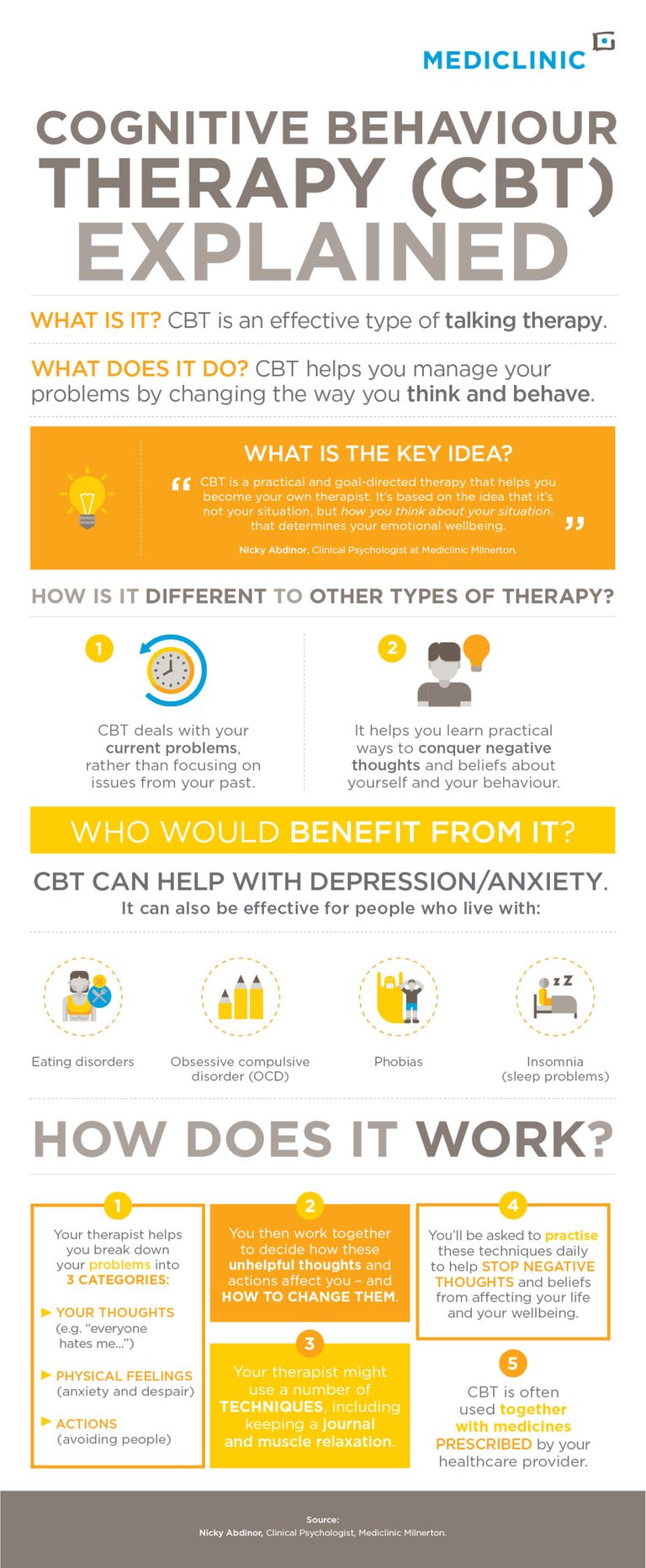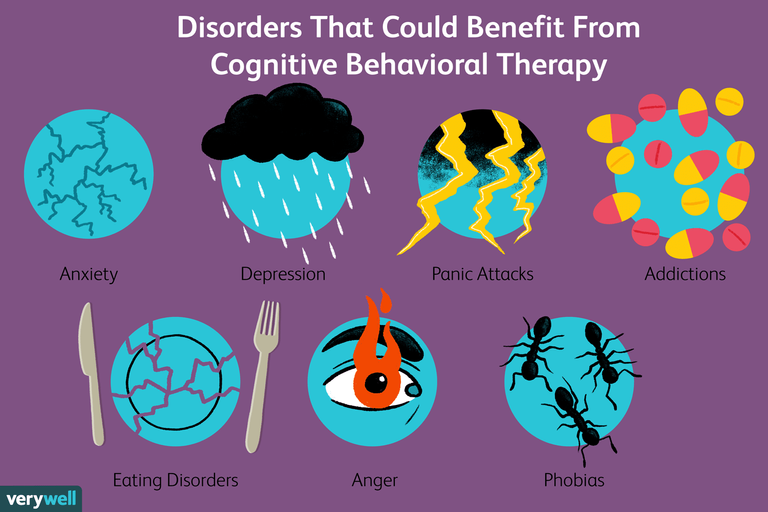Cognitive Behavioral Therapy (CBT) is one of the leading psychotherapeutic approaches used today. It focuses on helping individuals identify and change their dysfunctional thought patterns and problem behaviors in order to improve their mental health and overall well-being. In this article, three of the main techniques and strategies used in CBT will be highlighted: cognitive restructuring, systematic exposure and desensitization, and social skills training. Each of these techniques will be detailed and illustrated with examples of how they are applied in clinical practice.

Cognitive Restructuring
Cognitive restructuring is a core technique in CBT that involves identifying and modifying dysfunctional thought patterns that contribute to emotional and behavioral problems. The goal of this technique is to help the individual develop a more balanced and realistic perspective on themselves and their situation, rather than maintaining automatic, irrational negative thoughts. An example of irrational automatic thinking is "all or nothing" thinking. This thinking is characterized by seeing situations as extreme, with no shades of gray. An individual who has this type of thinking may believe that if something is not perfect, it is a total failure. This type of thinking can contribute to anxiety, depression, and low self-esteem.
Source

To help an individual overcome this dysfunctional thought pattern, the therapist can use the cognitive restructuring technique. The therapist can ask the individual to identify specific examples of "all-or-nothing" thoughts that they have experienced recently and then work with them to identify alternative, more balanced and realistic thoughts. For example, if an individual is feeling anxious because he has failed to complete all the tasks on his to-do list, the therapist can ask him to identify automatic negative thoughts he is having, such as "I'm a failure because I couldn't complete everything." The therapist can then help him find a more balanced and realistic perspective, such as "I did the best I could today and I can continue tomorrow."
Exposure and Systematic Desensitization
Another widely used technique in CBT is systematic exposure and desensitization. This technique is often used to treat phobias and other anxiety disorders, in which the individual experiences intense fear and avoids situations or objects that trigger that anxiety. Systematic exposure and desensitization involves gradually exposing the individual to anxiety-triggering stimuli while they learn to relax and control their emotional response. The goal is to help the individual overcome his anxiety and learn to cope with the situation in a more adaptive way.
For example, if an individual has a phobia of flying, the therapist can work with him or her to develop a hierarchy of exposure, starting with less threatening tasks, such as looking at pictures of airplanes, and gradually increasing the level of exposure until it reaches flying in an airplane. During each stage of exposure, the therapist can teach relaxation techniques, such as deep breathing or positive visualization, to help the individual control his anxiety. A study by Feske and Chambless (1995) evaluated the effectiveness of exposure and systematic desensitization in the treatment of social phobia. The results showed that systematic exposure and desensitization was more effective than either medication or placebo treatment, and that the effects of therapy were maintained over the long term.
Source

Social Skills Training
Social skills training is another technique used in CBT to help the individual develop more effective communication and relationship skills. This technique is often used in the treatment of social anxiety disorders and personality disorders. The goal of social skills training is to help the individual learn to express his or her emotions clearly and assertively, to handle difficult social situations, to develop healthy relationships, and to set appropriate boundaries.
For example, if an individual has difficulty expressing his needs and desires in interpersonal relationships, the therapist can use role-playing techniques to help him practice clear and assertive communication. The therapist can teach the individual to use "I" statements, rather than accusations, and to express their feelings in a non-judgmental way. A study conducted by Halford, Hayes, Christensen, and Craig (1994) evaluated the effectiveness of social skills training in treating couples in therapy. The results showed that social skills training was effective in improving communication and conflict resolution between couples, and that these effects were maintained over the long term.
Conclusion
Cognitive Behavioral Therapy is a widely used approach to psychotherapy, with many different techniques and strategies. In this article, we highlight three of the main techniques: cognitive restructuring, systematic exposure and desensitization, and social skills training. Cognitive restructuring involves identifying and modifying dysfunctional thought patterns, while systematic exposure and desensitization involves gradually exposing the individual to stimuli that trigger anxiety. Social skills training, meanwhile, is used to help the individual develop more effective communication and relationship skills. Each of these techniques is useful for treating different psychological and emotional problems, and they are often combined with other therapeutic strategies to achieve better results.
Source

CBT is a highly effective approach for treating psychological disorders, and much research has demonstrated its effectiveness in treating disorders such as depression, anxiety, eating disorders, and personality disorders. However, it is important to remember that CBT is not a one-size-fits-all approach for all problems, and that each individual is unique and may respond differently to treatment. The success of treatment depends on the therapist's skill and experience in adapting techniques according to the patient's individual needs and characteristics. Moreover, cognitive-behavioral therapy is not only an approach to treating psychological disorders, but can also be used to promote emotional well-being and improve people's quality of life. Through the use of techniques and strategies such as cognitive restructuring, systematic exposure and desensitization, and social skills training, CBT can help people develop more effective coping skills and achieve a more satisfying and fulfilling life. Thank you for reading and visiting!
References
Beck, A. T., Rush, A. J., Shaw, B. F., & Emery, G. (1979). Cognitive therapy of depression. New York: Guilford Press.
Feske, U., & Chambless, D. L. (1995). Cognitive-behavioral versus exposure only treatment for social phobia: A meta-analysis. Behavior Therapy, 26(4), 695-720.
Halford, W. K., Hayes, R. G., Christensen, A., & Craig, W. K. (1994). Effectiveness of couples therapy: A meta-analysis. Journal of Marital and Family Therapy, 20(4), 475-490.
Hofmann, S. G., Asnaani, A., Vonk, I. J. J., Sawyer, A. T., & Fang, A. (2012). The efficacy of cognitive behavioral therapy: A review of meta-analyses. Cognitive Therapy and Research, 36(5), 427-440.
Rachman, S. (1993). Obsessions, responsibility, and guilt. Behaviour Research and Therapy, 31(2), 149-154.
Rapee, R. M., & Heimberg, R. G. (1997). A cognitive-behavioral model of anxiety in social phobia. Behaviour Research and Therapy, 35(8), 741-756.
Wells, A. (1997). Cognitive therapy of anxiety disorders: A practice manual and conceptual guide. Chichester: Wiley.

Source

Português
A Terapia Cognitivo Comportamental (TCC) é uma das principais abordagens psicoterapêuticas utilizadas atualmente. Ela se concentra em ajudar o indivíduo a identificar e mudar seus padrões de pensamento disfuncionais e comportamentos problemáticos, a fim de melhorar sua saúde mental e bem-estar geral.

Neste artigo, serão destacadas três das principais técnicas e estratégias utilizadas na TCC: reestruturação cognitiva, exposição e dessensibilização sistemática, e treinamento de habilidades sociais. Cada uma dessas técnicas será detalhada e ilustrada com exemplos de como elas são aplicadas na prática clínica.
Reestruturação Cognitiva
A reestruturação cognitiva é uma técnica central na TCC, que envolve a identificação e modificação de padrões de pensamento disfuncionais que contribuem para problemas emocionais e comportamentais. O objetivo dessa técnica é ajudar o indivíduo a desenvolver uma perspectiva mais equilibrada e realista sobre si mesmo e sua situação, em vez de manter pensamentos negativos automáticos e irracionais. Um exemplo de pensamento automático irracional é o pensamento do tipo “tudo ou nada”. Esse pensamento é caracterizado por ver as situações como extremas, sem tons de cinza. Um indivíduo que tem esse tipo de pensamento pode acreditar que, se algo não for perfeito, é um fracasso total. Esse tipo de pensamento pode contribuir para a ansiedade, depressão e baixa autoestima.
Source

Para ajudar um indivíduo a superar esse padrão de pensamento disfuncional, o terapeuta pode usar a técnica de reestruturação cognitiva. O terapeuta pode pedir ao indivíduo que identifique exemplos específicos de pensamentos “tudo ou nada” que ele experimentou recentemente e, em seguida, trabalhar com ele para identificar pensamentos alternativos mais equilibrados e realistas. Por exemplo, se um indivíduo está se sentindo ansioso porque não conseguiu completar todas as tarefas em sua lista de afazeres, o terapeuta pode pedir a ele que identifique pensamentos negativos automáticos que ele está tendo, como "Eu sou um fracasso porque não consegui completar tudo." O terapeuta pode então ajudá-lo a encontrar uma perspectiva mais equilibrada e realista, como "Eu fiz o melhor que pude hoje e posso continuar amanhã".
Exposição e Dessensibilização Sistemática
Outra técnica amplamente utilizada na TCC é a exposição e dessensibilização sistemática. Essa técnica é frequentemente usada para tratar fobias e outros transtornos de ansiedade, nos quais o indivíduo experimenta medo intenso e evita situações ou objetos que desencadeiam essa ansiedade. A exposição e dessensibilização sistemática envolve a exposição gradual do indivíduo a estímulos que desencadeiam ansiedade, enquanto ele aprende a relaxar e a controlar sua resposta emocional. O objetivo é ajudar o indivíduo a superar sua ansiedade e a aprender a lidar com a situação de maneira mais adaptativa.
Por exemplo, se um indivíduo tem uma fobia de voar, o terapeuta pode trabalhar com ele para desenvolver uma hierarquia de exposição, começando com tarefas menos ameaçadoras, como olhar fotos de aviões, e gradualmente aumentando o nível de exposição, até chegar a voar em um avião. Durante cada etapa da exposição, o terapeuta pode ensinar técnicas de relaxamento, como a respiração profunda ou a visualização positiva, para ajudar o indivíduo a controlar sua ansiedade. Um estudo realizado por Feske e Chambless (1995) avaliou a eficácia da exposição e dessensibilização sistemática no tratamento da fobia social. Os resultados mostraram que a exposição e dessensibilização sistemática foi mais eficaz do que o tratamento com medicação ou o placebo, e que os efeitos da terapia foram mantidos a longo prazo.
Source

Treinamento de Habilidades Sociais
O treinamento de habilidades sociais é outra técnica utilizada na TCC para ajudar o indivíduo a desenvolver habilidades de comunicação e relacionamento mais eficazes. Essa técnica é frequentemente usada no tratamento de transtornos de ansiedade social e transtornos de personalidade. O objetivo do treinamento de habilidades sociais é ajudar o indivíduo a aprender a expressar suas emoções de maneira clara e assertiva, a lidar com situações sociais difíceis, a desenvolver relacionamentos saudáveis e a estabelecer limites apropriados.
Por exemplo, se um indivíduo tem dificuldade em expressar suas necessidades e desejos em relacionamentos interpessoais, o terapeuta pode usar técnicas de role-playing para ajudá-lo a praticar a comunicação clara e assertiva. O terapeuta pode ensinar o indivíduo a usar "eu" declarações, em vez de acusações, e a expressar seus sentimentos de maneira não julgadora.
Um estudo conduzido por Halford, Hayes, Christensen e Craig (1994) avaliou a eficácia do treinamento de habilidades sociais no tratamento de casais em terapia. Os resultados mostraram que o treinamento de habilidades sociais foi eficaz em melhorar a comunicação e a resolução de conflitos entre casais, e que esses efeitos foram mantidos a longo prazo.
Conclusão
A Terapia Cognitivo Comportamental é uma abordagem amplamente utilizada na psicoterapia, com muitas técnicas e estratégias diferentes. Neste artigo, destacamos três das principais técnicas: reestruturação cognitiva, exposição e dessensibilização sistemática e treinamento de habilidades sociais. A reestruturação cognitiva envolve a identificação e modificação de padrões de pensamento disfuncionais, enquanto a exposição e dessensibilização sistemática envolve a exposição gradual do indivíduo a estímulos que desencadeiam ansiedade. O treinamento de habilidades sociais, por sua vez, é utilizado para ajudar o indivíduo a desenvolver habilidades de comunicação e relacionamento mais eficazes. Cada uma dessas técnicas é útil para o tratamento de diferentes problemas psicológicos e emocionais, e muitas vezes são combinadas com outras estratégias terapêuticas para alcançar melhores resultados.
Source

A TCC é uma abordagem altamente eficaz para o tratamento de transtornos psicológicos, e muitas pesquisas têm demonstrado a sua eficácia no tratamento de transtornos como depressão, ansiedade, transtornos alimentares e transtornos de personalidade. No entanto, é importante lembrar que a TCC não é uma abordagem única para todos os problemas, e que cada indivíduo é único e pode responder de forma diferente ao tratamento. O sucesso do tratamento depende da habilidade e experiência do terapeuta em adaptar as técnicas de acordo com as necessidades e características individuais do paciente. Além disso, a terapia cognitivo-comportamental não é apenas uma abordagem para o tratamento de transtornos psicológicos, mas também pode ser usada para promover o bem-estar emocional e melhorar a qualidade de vida das pessoas. Por meio do uso de técnicas e estratégias como a reestruturação cognitiva, a exposição e dessensibilização sistemática e o treinamento de habilidades sociais, a TCC pode ajudar as pessoas a desenvolver habilidades de coping mais eficazes e a alcançar uma vida mais satisfatória e plena. Obrigado pela leitura e visita!
Referências
Beck, A. T., Rush, A. J., Shaw, B. F., & Emery, G. (1979). Cognitive therapy of depression. New York: Guilford Press.
Feske, U., & Chambless, D. L. (1995). Cognitive-behavioral versus exposure only treatment for social phobia: A meta-analysis. Behavior Therapy, 26(4), 695-720.
Halford, W. K., Hayes, R. G., Christensen, A., & Craig, W. K. (1994). Effectiveness of couples therapy: A meta-analysis. Journal of Marital and Family Therapy, 20(4), 475-490.
Hofmann, S. G., Asnaani, A., Vonk, I. J. J., Sawyer, A. T., & Fang, A. (2012). The efficacy of cognitive behavioral therapy: A review of meta-analyses. Cognitive Therapy and Research, 36(5), 427-440.
Rachman, S. (1993). Obsessions, responsibility, and guilt. Behaviour Research and Therapy, 31(2), 149-154.
Rapee, R. M., & Heimberg, R. G. (1997). A cognitive-behavioral model of anxiety in social phobia. Behaviour Research and Therapy, 35(8), 741-756.
Wells, A. (1997). Cognitive therapy of anxiety disorders: A practice manual and conceptual guide. Chichester: Wiley.

Source
reestruturação é pra lidar com ansiedade constante, exposição dessensi é pra evitar surtos de ansiedade e o 3o ali é pra ansiedade social? legal, bem prático, mesmo
O bom da TCC é que é bem prática e baseada em protocolos né. É pra ansiedade social sim, principalmente por que em um certo nível essas ansiedades e fobias deixam a gente debilitados, se a pessoa vive assim meio que "não treina" lidar com o mundo e vai ficando cada vez mais difícil enfrentar e quando enfrenta tende a se sair mal por pura falta de traquejo, habilidade. É um negócio de esforçar-se para aprender a viver no mundo normal, meio que vestindo uma máscara inicialmente, e com o tempo vai naturalizando.
This is helpful and very informative, thank you for sharing this, I never knew anything about Psychotherapy until reading this article.
Psychotherapy can be very helpful and is not scary (or even useless) as some may think, especially this therapeutic method. It helps too much!
Obrigado por promover a comunidade Hive-BR em suas postagens.
Vamos seguir fortalecendo a Hive
Thanks for your contribution to the STEMsocial community. Feel free to join us on discord to get to know the rest of us!
Please consider delegating to the @stemsocial account (85% of the curation rewards are returned).
You may also include @stemsocial as a beneficiary of the rewards of this post to get a stronger support.